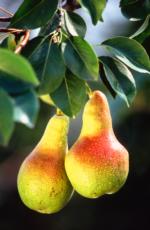Pear (European: Pyrus communis L; Asian: Pyrus serotina L.)
Of all the deciduous fruit tree species, pears are the most tolerant of wet soil conditions. Yet they perform best on deep, well-drained sites. Pears are the most pest-ridden of all fruit trees and require the most sprays to keep clean.
Pear trees grow very large, requiring a 18×18 ft. spacing, without dwarfing rootstock or summer pruning. Trees also have a tendency to grow very upright and must be trained to develop a spreading growth habit.
Most pear varieties are self-sterile and require cross-pollination by another variety to get a good crop set. One exception is the Sacramento River delta region where “Bartlett” is self-fruitful, setting crops of parthenocarpic fruits. Fire blight (bacterial disease) is a serious problem in pears.
“Bartlett,” which makes up 75% of the world’s production and acreage, has a chilling requirement of about 1500 hours. Days from full bloom to harvest range from about 115 to 165 for European and Asian pears.
Calendar of Backyard Gardening Operations for Pears
Winter Dormant Season
- Spray trees with dormant oil to control San Jose scale, aphid eggs, mite eggs and overwintering adult pear psylla.
- Prune 20% last year’s growth to let light in.
- Remove diseased (fire blighted) and broken limbs.
Spring Bloom Season
- Spray trees with a fungicide to control pear scab at green tip stage, full bloom and at 10-day intervals until rain stops
- Thin pears to 6" apart if crop is heavy.
- Fertilize prior to first irrigation.
- Apply 1.5 lb. urea or 40 lb. manure.
Summer Growing Season
- Fertilize young trees monthly using half spring rates.
- Spray monthly (May 1 – August 1) to control codling moth worms. Time sprays to visual ID of worm holes in fruit.
- Control aphids if damage exceeds 50% leaves crinkled and aphids present.
- Drip irrigate daily or sprinkler irrigate every 2–3 weeks.
Fall Harvest Season
- Using spring rates, fertilize and irrigate mature trees right after harvest.
- Clean up fallen fruit to reduce codling moth.
- At leaf fall, remove and destroy or compost leaves to prevent the spread of apple scab.
Resources
- [PDF] Pear Varieties for Planting in the Home Garden, Paul Vossen and Deborah Silver, Sonoma and Marin Co. UCCE
- [PDF] Apples and Pears: Calendar of Operations for Home Gardeners, Pamela M. Geisel and Carolyn L. Unruh, Fresno County and Paul Vossen, Sonoma and Marin County
- How to Manage Pests in Gardens and Landscapes - Fruits and Nuts, UC IPM
Asian Pear
- Asian Pear Links, UC Fruit and Nut RIC
European Pear
- European Pear Links, UC Fruit and Nut RIC
- Guidelines to Evaluate Pears for Commercial Planting in the Sierra Nevada Foothills, Dick Bethell, El Dorado Co. UCCE
